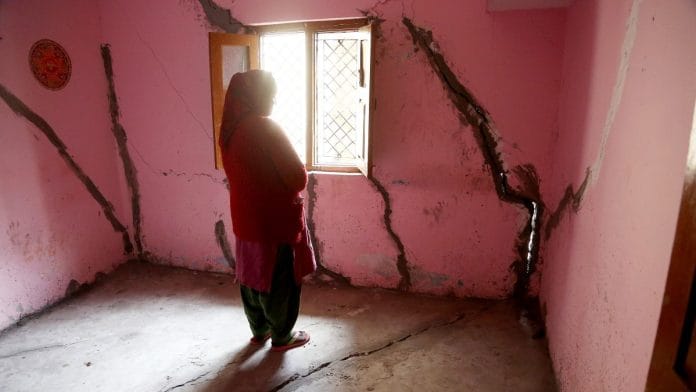Thank you dear subscribers, we are overwhelmed with your response.
Your Turn is a unique section from ThePrint featuring points of view from its subscribers. If you are a subscriber, have a point of view, please send it to us. If not, do subscribe here: https://theprint.in/subscribe/
What?
A situation in which a house gets sick due to its wrong location, architecture and furnishings. It suffers from land, air, water, noise and biological pollution. Its back yard is barren, layout stifling, indoor air polluted, potable water contaminated, noise levels irritating and household pests thriving in its furnishings.
Who?
A sick home affects its occupants and occupants lifestyles make the home sick. Both residents and guests of all age groups get affected immediately or gradually. The occupants feel sick without any physical illness. They feel disturbed and uncalm without any mental problems.
Where?
Houses at wrong locations, constructed or furnished wrongly or where occupants have wrong lifestyles. Wrong location means a house on degraded land, flood plains or in the wrong zone. Degraded land undermines its stability, non residential industrial zones are prone to all types of pollution. Houses on forest land lead to depletion of natural resources, potential disruption of local ecosystems and climate change.
Wrong architecture means homes with flawed layout, wasted space, inadequate natural light, poor ventilation and constructed with toxic building materials.
Furnishings are wrong when not weather appropriate. Heavy carpets, curtains and sofas breed allergens and trap dust.
Wrong lifestyle is smoking indoors, using aerosol sprays, chemical adhesives & cleaners, chlorine bleach, high phosphate soaps, single use plastics, and burning fossil fuel or garbage indoors and choking the plumbing system with sanitary napkins etc.
When?
When a house is on degraded land it’s unstable on flood plains it leads to erosion, poor water quality, destruction of biodiversity and is an environmental crime. When a house is facing the wrong direction and architecture it would suffer from insufficient light, damp, stuffy and smelly surfaces and poor ventilation.
Why?
Structurally unsound houses have cracks and dead spaces where rats, termites, cockroaches, etc hide and thrive.
Houses on flood plains hinder the flow of water. Flooding sweeps the houses away or causes cracked foundations, damaged walls, warped floors, compromised roofs, mold growth, diseases and allergies.
Lifestyles with throw away culture, disposable clothing, single-use plastic bottles/ coffee cups and replacing electronics frequently lead to not only resource depletion, climate change but also sick home syndrome.
Symptoms residents show
- Concurring dry, watery or burning eyes and blurred vision.
2.Concurring dry or watery nose, respiratory irritation, wheezing, shortness of breath
and dry irritated throat with mucus laden with germs.
- Skin irritated, itchy, inflamed, swollen, discolored, scaly, patchy with rough bumps.
- Sharp or throbbing headaches, light headedness or unsettled stomach.
- Difficulty in concentrating, focusing on a task or difficulty staying awake.
- Chronic tiredness, fatigued, burnt out, exhausted, lack of energy and slow reflexes.
Save yourself
Construct only on land demarcated as residential area and follow the zoning laws. Live in an authorised residential colony on legally acquired land. Construct in a way that stale indoor air gets exchanged with fresh outdoor air regularly, has ample sunlight, minimum use of active energy and maximum use of passive energy and is integrated with nature. Only use water based, eco friendly paints made with natural ingredients like clay, plant oil and plant dyes instead of heavy metals and VOCs. Only use natural fabrics like cotton, wool, silk or bamboo instead of non biodegradable synthetic fibres derived from petroleum. .Get furniture made from recycled metal, wood etc instead of high glue content boards. Let metal strips separate the woodwork from the soil and save the house from termites. Do not let the pipelines become an abode of rats and keep cockroaches away by eliminating any ‘atta’ on kitchen slabs and under the gas ‘chullas’.
Conclusion
In the early and mid 1900s there was no Sick Home Syndrome. Reasons were good ventilation and near natural homes. The building ventilation standards were approximately 15 cubic feet per minute (cfm) of outside air for each building occupant. The chemical contaminants from adhesives, carpeting, upholstery, manufactured wood products, copy machines, pesticides,improper garbage or sewage disposal, un potable water, unsafe electrical wiring, and unregulated noise levels had not engulfed our homes.
However over the years building ventilation standards got reduced to 5 cfm per occupant. We got away from the natural world to the synthetic world. Sick Home Syndrome started.
A 1984 World Health Organization Committee report suggested that up to 30 percent of new and remodeled buildings worldwide may be the subject of excessive complaints related to indoor air quality (IAQ) which can lead to Sick Building Syndrome. Frequently, problems result when a building is ill operated or ill maintained. Sometimes indoor air problems are a result of poor building design or occupant activities.
The easiest solution to Sick Home Syndrome is removal, modification or dilution of pollutants at the source of their generation. Living in healthy homes is staying healthy.
These pieces are being published as they have been received – they have not been edited/fact-checked by ThePrint


